evidences
footprints
|
The footprint of a tree or rock, which is the shape of that entity where it meets the earth, is abstract, realistic and conceptual at once. Since the traced shape consists of organic, asymmetric curves with no apparent connection to the appearance of any specific organism, the footprint is an abstraction until the viewer becomes aware of its origin.
Taking a tree footprint as an example, the shape is realistic in the sense that it is made from a pattern traced from one specific tree. The variety of tree, its GPS location, its girth, and other identifying information may be recorded to reinforce that it is a specific tree in a particular location. The viewer could find that particular specimen. The form is also conceptual since the recorded contour does not physically exist. The roots continue below the edge where the earth meets the trunk; there is no actual line on the tree. |
|
"The shape is amoeba-like or, for the mathematically inclined, fractal. As a work of art, it could stand on its own even if the viewer didn't know, from the title and the exhibit catalogue, of its origins in the natural world."
- Merrill Kaitz."The center cannot hold - or can it?" Amesbury News, June 14, 2002 still images
|
|
|
driplines
|
So too, recording the dripline of a rock or other entity yields a shape that is also abstract, realistic and conceptual. Driplines simply record the entity's outermost perimeter. Imagine there was a rainstorm and you could see the edge where the shape of the rock or tree leaves a dry area.
The footprint and dripline patterns are not the actual artwork. The art is subsequently made from the patterns in other media. These evidences have all been made from geographically distant organisms. When exhibited in groupings, they unite organic entities in Alaska, Tennessee, Iceland, Maine, Massachusetts, California, New York and other locales, an additional conceptual consideration. |
|
White Pine Dripline, MA , Phragmites reeds, steel rods, paint, 12'x65'x65' / 4x21x21m, 2004. Outdoor Sculpture at Maudslay State Park, Newburyport, MA. photos: Egils Zarins
White Pine Dripline, MA marked the outermost reach of one white pine tree. Phragmites are invasive reeds that grow nearby and which I cut, stripped of leaves and painted. Eighteen inch lengths of 1/4" steel rod were pounded half way into the ground along the dripline and the reeds slid over these. While I was installing, I intended to use a laser pointer to locate the outermost tips of branches above to locate the dripline. However, the laser beam was not visible in sunlight. Two passing engineers suggested that radar would have been more effective. This white pine had once dropped a huge branch so close to me as I was running past in a storm that it scraped my hand. My relationship with this tree was therefore mutual and never passive. "Joyce Audy Zarins zeroed in on a tree in the park that she previously sought protection under in the face of an approaching storm. To create "White Pine Dripline," she planted a series of reeds into the ground at the edges of the branches to delineate the top layer of earth that is affected by the tree. Painted red, the reeds indicate passion, danger or force." - Sonya Vartabedian. "Revealing layers," The Daily News, Newburyport, June 10, 2004 |
|
Eric’s Birch Sapling Driplines, IS, painted steel, 21” x 19” / 53 x 48 cm, 27” x 23” / 69 x 58 cm, 2004. Patterns made in Vogar, Iceland. Shown at Elizabeth A. Beland Gallery, Essex Art Center, Lawrence, MA, 2008. photo: Egils Zarins
In many parts of Iceland trees must struggle to survive. The two birches these evidences were traced from were small enough that even their driplines were diminutive, though intriguing. These shapes were achieved by my helper Eric tracing the outermost branches with a plumb bob on a string while I recorded the shape it outlined. I chose steel as a medium to represent the fortitude these trees need to grow under difficult conditions. Both small birches eventually succumbed. |

